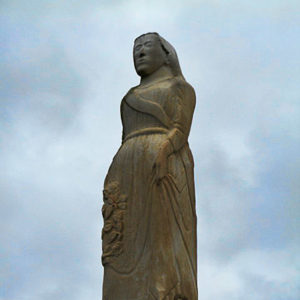calsfoundation@cals.org
Lucy J. Daniel (1865–1957)
In the late 1800s, it was so unusual for women to be stone carvers that The Monumental News, a trade journal, was able to locate only three to write about—one of whom was Lucy J. Daniel, formerly of Arkansas. The others were from Kansas and Canada, and all had learned the trade from their fathers. The journal article noted that Daniel had been fully in charge of the family’s marble shop since 1885, doing all the lettering, and some cutting and polishing, of the tombstones. Her only known sculpture is the Goddess of Liberty statue at Pea Ridge National Military Park.
Lucy Jane Daniel was born in May 1865 in Carter County, Kentucky. Her mother was Rebecca Jane (Remy) Daniel, and her father was Union veteran Isom Daniel, who served in the Twenty-third Regiment, Kentucky Infantry; Lucy Daniel had four siblings. The Daniel family came to Sebastian County, Arkansas, from Kentucky by the time of the 1880 census. In 1883, the family moved to Springdale (Washington and Benton counties), then left for Missouri three years later, where Lucy Daniel carved the Goddess of Liberty statue. After running marble businesses at Cassville, O’Day, and Exeter, Missouri, Daniel—and perhaps her parents—moved to Meade, Kansas, in 1902. There, Daniel homesteaded two land claims and carved numerous tombstones. On the 1910 census, she, her parents, and her brother James were listed as living in Dome, Nebraska, where they were all involved in the monument business.
When the Goddess of Liberty statue at Pea Ridge National Military Park was dedicated at a reunion of Civil War veterans on September 5, 1889, it was hailed as the first monument ever created to honor the “perpetual friendship” between Union and Confederate soldiers. This monument—also known as Angel Aloft or Reunited Soldiery due to inscriptions on the pedestal—was unveiled by Isom Daniel before a crowd of more than 3,000 at Elk Horn Tavern, on the battlefield, at the veterans’ third reunion.
Daniel carved her sculpture and its bases from Vermont and Maine statuary marble, setting these atop blocks of sandstone that came from the battlefield. This sculpture is a work so stylized that it resembles folk art. Reporting on the unveiling, the Arkansas Gazette dismissed it, saying, “The work is very crude and resembles nothing to speak of,” a sentiment later repeated by other writers. Nothing is known about how Daniel came to carve this sculpture, though the newspaper noted that she intended it as a gift to the veterans.
The statue and its stacked, columnar bases incorporate mourning motifs of the period: a wreath of roses and lilies, a hand pointing heavenward, and clasping hands. Though a handclasp traditionally denotes a farewell to the dead, here it symbolizes reconciliation between the two sides. Also included are names of the ranking officers at the Battle of Pea Ridge: Major General Samuel R. Curtis (Union) and Major General Earl Van Dorn (Confederate). The statue’s base contains a lengthy poem, reportedly composed by Captains J. B. Lamkin and Puckett (Puckett’s first name is unknown) and Professor John R. Roberts; Lamkin also made the “address of reception” at the statue’s unveiling. The poem seeks to unite the two sides “in peace and love.”
In 1887, on the twenty-fifth anniversary of the Battle of Pea Ridge, Confederate veterans held a reunion near this site, an event so popular with soldiers from both sides that it became a yearly event. Daniel may have received her inspiration from the veterans’ second reunion, in 1888. At this event, thirty-five girls performed a dance drama titled “Secession and Reunion” around a figure called “Miss Goddess of Liberty.”
Daniel married John Twigg in Nebraska in 1912, after he homesteaded land next to hers. The two separated in about 1917; from then on, they each claimed to have been widowed. John Twigg died in Texas in 1945.
By the 1920 census, Daniel was back in Arkansas, living with her parents in Baxter County, having no profession. Following their deaths, she and sister Stella Daniel, later joined by their brother James, continued to live in the family home. After James was found dead under somewhat mysterious circumstances in 1943, the sisters relocated to Garfield (Benton County). Stella died the following year, after which Lucy returned to Missouri, living in Exeter, then Ridgley, with another sister. The two died in 1957 and are buried in Exeter’s Maplewood Cemetery.
For additional information:
“At Elk Horn.” Arkansas Gazette, September 8, 1889, p. 2.
Burnett, Abby. “Silent Vigil: The Work of Stone Carver Lucy Daniel Twigg.” Flashback 70 (Summer 2020): 74–85.
“Miss Lucy J. Daniel.” The Monumental News 7 (January 1895): 92. Original online at http://www.quarriesandbeyond.org/cemeteries_and_monumental_art/pdf/monumental_news_jan_1895.pdf (accessed February 7, 2022).
Seamster, Alvin. “Reunions of Blue and Gray.” Rogers, AR: Shofners, n.d. On file at Springdale Public Library, Springdale, Arkansas.
“Some Women Marble Cutters [Reprint].” The Monumental News 51 (December 1939): 120. Original online at http://quarriesandbeyond.org/articles_and_books/images/mo-some_women_marble_cutters_mon_news.jpg (accessed February 7, 2022).
Abby Burnett
Kingston, Arkansas
 Goddess of Liberty
Goddess of Liberty 




Comments
No comments on this entry yet.